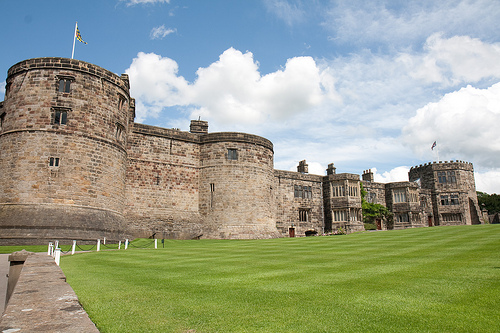

Location: Skipton, North Yorkshire Map
Constructed: 1090 by Robert de Romille
Tel. 01756 792442
Open:
daily
Closed: 25 Dec
Entrance Fee: adult £5.80
children (5- 15 yrs)
£3.20
Official site
Skipton Castle is a remarkably well-preserved medieval fortress located in the market town of Skipton, North Yorkshire, England, at the northern end of the High Street (coordinates approximately 54°15′48″N 2°00′54″W). Overlooking the town and serving as the gateway to the Yorkshire Dales National Park, it was originally built around 1090 by Norman baron Robert de Romille as a motte-and-bailey structure to assert control over the region following the Conquest. Rebuilt in stone and expanded over centuries, it stands as one of England's most complete medieval castles, fully roofed and intact, blending military strength with domestic features. Owned by the Fattorini family since 1956, it functions as a popular tourist attraction, drawing visitors for its historical significance, architectural integrity, and scenic setting amid the Dales' rolling hills and Eller Beck stream. The castle's strategic position on a natural rise, backed by a steep cliff, provided natural defenses against Scottish raids, while today it offers panoramic views of the surrounding countryside and proximity to local amenities like markets and the Leeds-Liverpool Canal.
The castle's origins date to circa 1090 when Robert de Romille constructed a timber motte-and-bailey fort to secure Norman holdings in upper Wharfedale and Airedale, granted by William the Conqueror. After the Romille line ended around 1310, Edward II bestowed it upon Robert Clifford, who fortified it further as Lord Clifford of Skipton and Guardian of Craven. The Cliffords, a powerful northern family, held it for generations, withstanding Scottish incursions like the Great Raid of 1322. During the English Civil War (1642–1651), it became the last Royalist bastion in the north, enduring a three-year siege from 1643 to 1645 under Sir John Mallory. Legend claims sheep fleeces cushioned cannon impacts, inspiring the town's coat of arms. Oliver Cromwell ordered its slighting (demolition of roofs and walls) post-surrender, but Lady Anne Clifford (1590–1676), the last Clifford owner, restored it extensively after inheriting in 1649, planting a commemorative yew tree in 1659. The castle served as the Cliffords' principal seat until 1676, then passed to the Tufton family (Earls of Thanet) and later Lord Hothfield in 1871. In 1956, the Fattorini family acquired it, preserving it as a public monument. Recent discoveries, like an ancient well, illuminate siege survival tactics, while the site marks the start of the 100-mile Lady Anne's Way footpath to Penrith.
Skipton Castle exemplifies medieval concentric design, rebuilt in millstone grit sandstone for durability against attacks. Its core features a twin-towered Norman gatehouse with portcullis grooves, drawbar slots, and masons' marks, leading to the inner bailey. Six drum towers fortify the structure, connected by a domestic range on the north side, protected by a precipice over Eller Beck. The first floor houses the original kitchen, great hall (now the Banqueting Hall), withdrawing rooms, and lord's bedchamber, while the ground level includes later kitchens, storage cellars, and a privy with waste chute. Military towers dominate, with the large Watch Tower offering defensive oversight. Tudor additions (16th–17th centuries) include a new entrance staircase (replacing a drawbridge), expanded domestic wings, and larger windows for light. The central Conduit Court, a Tudor courtyard, centers on Lady Anne Clifford's yew tree and a cistern-fed conduit for water. An outer curtain wall encloses wards and outbuildings, including a 12th-century chapel ruin and a rare 17th-century shell grotto in the east tower. Fully roofed since Lady Anne's restorations, the castle retains intact interiors like the crowded medieval kitchen and dungeon, blending fortress utility with later residential comforts.
While primarily a fortress, Skipton Castle includes modest grounds enhancing its appeal. The Conduit Court serves as a central green space with the iconic yew tree. Surrounding areas feature a picnic spot for relaxation, clean gardens, and woodlands ideal for short walks. The castle overlooks Eller Beck and is backed by cliffs, integrating natural defenses with scenic beauty. No extensive formal gardens exist, but the well-maintained outdoor spaces support wildlife and provide views of the Yorkshire Dales. Visitors praise the tidy lawns and paths, though some note limited greenery compared to other sites.
As of September 22, 2025—a Monday—Skipton Castle is open daily from 10:00 AM (Sundays from 11:00 AM in some sources), with last admission at 5:00 PM (4:00 PM October–March) and closing at 6:00 PM. It is closed December 23–25. Admission prices are approximately £12.40 for adults, £8.30 for children (5–17), with under-5s free; online booking is recommended for guaranteed entry and potential savings. Facilities include a tea room/café with table service (noted for good food but sometimes overpriced), a gift shop for souvenirs and books, clean toilets, and a picnic area. Self-guided tours use a detailed tour sheet (available in 10 languages) with 40 drawings, allowing exploration of rooms like the Banqueting Hall, kitchen, bedchamber, privy, dungeon, and Watch Tower—typically taking 1–2 hours. Accessibility is limited due to steep, uneven stairs (about 80 steps total), making it challenging for those with mobility issues; no elevators, but ground-level areas are navigable. Staff are friendly and knowledgeable, aiding with queries or lost items. TripAdvisor rates it 4.4/5 from 2,465 reviews, with 2025 feedback praising its preservation, history (e.g., Clifford family and Civil War ties), and family suitability, though some criticize sparse furnishings, outdated tour sheets, and high fees for a short visit. Events may include seasonal activities; check the website for updates. Free Wi-Fi is available since 2021. Parking is nearby in town (pay-and-display), and the site is dog-free indoors but welcomes them in grounds on leads.